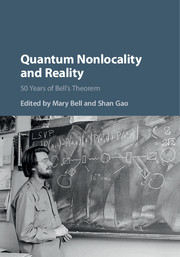Book contents
- Frontmatter
- Contents
- Contributors
- Preface
- Preface
- Part I John Stewart Bell: The Physicist
- Part II Bell's Theorem
- Part III Nonlocality: Illusion or Reality?
- 9 Strengthening Bell's Theorem: Removing the Hidden-Variable Assumption
- 10 Is Any Theory Compatible with the Quantum Predictions Necessarily Nonlocal?
- 11 Local Causality, Probability and Explanation
- 12 The Bell Inequality and the Many-Worlds Interpretation
- 13 Quantum Solipsism and Nonlocality
- 14 Lessons of Bell's Theorem: Nonlocality, Yes; Action at a Distance, Not Necessarily
- 15 Bell Nonlocality, Hardy's Paradox and Hyperplane Dependence
- 16 Some Thoughts on Quantum Nonlocality and Its Apparent Incompatibility with Relativity
- 17 A Reasonable Thing That Just Might Work
- 18 Weak Values and Quantum Nonlocality
- Part IV Nonlocal Realistic Theories
- Index
- References
10 - Is Any Theory Compatible with the Quantum Predictions Necessarily Nonlocal?
from Part III - Nonlocality: Illusion or Reality?
Published online by Cambridge University Press: 05 September 2016
- Frontmatter
- Contents
- Contributors
- Preface
- Preface
- Part I John Stewart Bell: The Physicist
- Part II Bell's Theorem
- Part III Nonlocality: Illusion or Reality?
- 9 Strengthening Bell's Theorem: Removing the Hidden-Variable Assumption
- 10 Is Any Theory Compatible with the Quantum Predictions Necessarily Nonlocal?
- 11 Local Causality, Probability and Explanation
- 12 The Bell Inequality and the Many-Worlds Interpretation
- 13 Quantum Solipsism and Nonlocality
- 14 Lessons of Bell's Theorem: Nonlocality, Yes; Action at a Distance, Not Necessarily
- 15 Bell Nonlocality, Hardy's Paradox and Hyperplane Dependence
- 16 Some Thoughts on Quantum Nonlocality and Its Apparent Incompatibility with Relativity
- 17 A Reasonable Thing That Just Might Work
- 18 Weak Values and Quantum Nonlocality
- Part IV Nonlocal Realistic Theories
- Index
- References
Summary
Introduction
Important advances in scientific knowledge may, not infrequently, be looked at from several angles. Here, in investigating the question the article title defines, part of our attention will have to be turned on the relationships of Bell's theorem to the old, but still not fully cleared up, question of the nature of causality.
The word “nonlocality” means the violation of local causality, the initial meaning of whichwas that no influence, that is, no causal action, can be propagated faster than light. For a long time it was a received view that actions somewhat akin to the basically time-directed ones that living beings perform also take place within inanimate nature. This conception of causality may be called the causality–action theory. But later, having in view Hume's serious reservations concerning it, renowned philosophers of science claimed it might and should be dropped, since the effects it was meant to account for could be explained just as well by considering that what is at work is simply a conjunction of physical laws expressed by means of differential equations – a view that later Hempel and Oppenheim generalized and called the D-N (deductive–nomological) model of explanation (reprinted in [1]). Here the (widely accepted, as it seems) corresponding conception of causality will, for simplicity, be called the law-centered theory of causality.
But does the latter theory subsume, at least within physics, all the meanings of the word ‘cause’ that true understanding calls for? Among philosophers the matter is not settled. Hempel himself granted that in several respects the D-N model is somehow inadequate for analyzing the cause–effect relationship [2]. And it seems indeed that a significant argument favoring a ‘no’ answer to the question might have been put forward as early as 1907 (although, to our knowledge, it was not), when Einstein pointed out that according to his then two years old special relativity (SR) theory, if we assumed an effect could follow its cause sooner than light velocity permits, then in some other frames of reference it would occur before its cause. For, concerning this consequence of the assumption, he wrote, “in my opinion, regarded as pure logic … it contains no contradiction; however it absolutely clashes with the character of our total experience, and in this way is proved the impossibility of the hypothesis” [3].
Information
- Type
- Chapter
- Information
- Quantum Nonlocality and Reality50 Years of Bell's Theorem, pp. 160 - 171Publisher: Cambridge University PressPrint publication year: 2016
